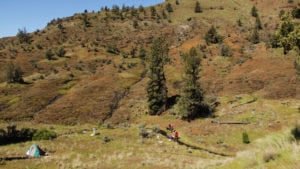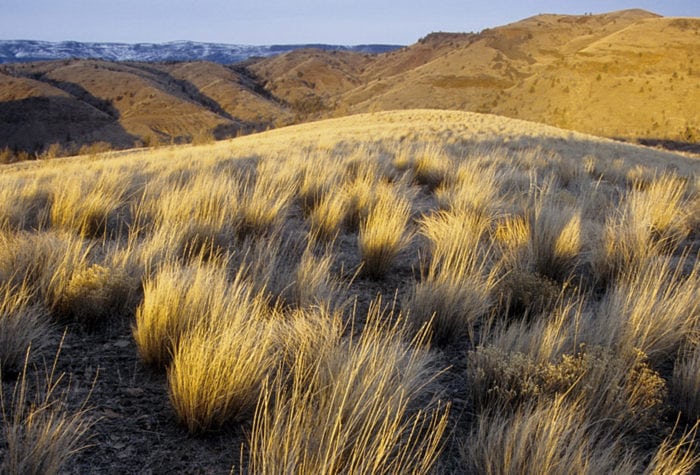Muleshoe Creek Riparian Restoration Project March 19-22
| Organizer: Jefferson Jacobs
Start Date: 3/19/2018 End Date: 3/22/2018 Region: John Day River Basin River Basin Difficulty Rating: 2 out of 5 Maximum Group Size: 12 participants |
About the place
Muleshoe Creek is a tributary of the upper John Day near Service Creek. The mile-long reach of stream is protected by conservation easements. Significant restoration work is already underway here: the ranch upstream has conducted significant juniper cutting and the landowner cooperating with us has done juniper work as well as riparian plantings, caging and repaired all the boundary fences. However, despite significant growth in the riparian vegetation and a positive response of upland vegetation, some gaps still remain in species diversity, and maintaining surface flow throughout the year. ONDA has been invited to help remedy this situation.
View the map.
About the stewardship work
 Our work on the project in the spring will entail planting additional riparian trees in the form of cut “slips” or sticks. No experience is necessary: we will teach you everything you need to know to work safely and ensure a high chance of survival for the plants. There is ample opportunity to work at your own pace and on aspects that work best with your physical capabilities.
Our work on the project in the spring will entail planting additional riparian trees in the form of cut “slips” or sticks. No experience is necessary: we will teach you everything you need to know to work safely and ensure a high chance of survival for the plants. There is ample opportunity to work at your own pace and on aspects that work best with your physical capabilities.
Trip timeline
- Monday, March 19, 5 p.m.: We will meet at the worksite in Muleshoe Creek. Meet the land-owner, set up camp and discuss the plans for the coming day.
- Tuesday, March 20, 8 a.m.: walk the 100 yards or so to where we will start our work for the day. Be prepared for a day of physical labor, and doing some creative planting of willows directly into the stream bed.
- Wednesday, March 21, a.m.: Another full day of work.
- Thursday, March 22, 9 a.m.: After breakfast, we will break down camp and head home.
Camp
We will be car camping Muleshoe Creek itself, within walking distance of the work sites. This is not a developed/commercial campground (see map link above).
Difficulty
Weather at this time of year can be cold and rainy or warm and sunny, so folks will need to be adaptable as we will be working rain or shine. While work will be physical and last all day, there is ample opportunity to rest and pace oneself according to each person’s ability.
Trip highlights and challenges
- Getting to help be part of a project that is putting the “finishing touches” on improving an area: lets you see a jump start in the progress of these sorts of restoration projects.
- Experience the satisfaction of doing work that you can look back at and see a difference: even from Google Earth in a few years!
- Some of the work can be physically strenuous and potentially wet, and temperatures can fluctuate widely during this time of year.
Participant responsibilities
Participants are responsible for their own food, camping gear as well as transportation to and from the trip. Sturdy off-trail ankle-high boots or rubber knee-boots are needed for this trip. Participants should be prepared to be away from camp all day each of the work days.
Gear provided
ONDA will provide tools for the work, some group camping equipment (shade tent, tables for cooking, wash bins for kitchen cleanup, an outhouse, and some camp chairs), expert leadership, and we can teach you all you need to know about riparian restoration! And yes, I will have hot water ready for folks to use at mealtimes, and espresso waiting for folks in the morning.
Registration
An ONDA registration application and medical form are required for this trip.
Apply Now
You only need to fill this form out once per year and can join additional trips this year by emailing the trip leader directly. You will receive a confirmation email within 10 working days of submitting your form. The confirmation email will provide information regarding which trips you are on the “participant list” for, and which trips are full, and therefore you have been placed on the “waitlist.”
Six weeks before the start of the trip, the trip leader will send out an RSVP to make sure everyone is still able to participate. Based on RSVPs, open spaces will be backfilled with people from the waitlist.
Three weeks before the trip start date, registered and confirmed participants will receive driving instructions, maps, carpooling options, and additional information in an email sent by the trip leader
If you have any questions in the meantime, please don’t hesitate to contact the trip leader.
This trip will be led by ONDA's Riparian Restoration Coordinator, Jefferson Jacobs. jjacobs@onda.org (5410 330-2638
ONDA's Restoration and Stewardship Work
Over the last two decades, ONDA has engaged volunteers in projects to plant thousands of trees, restore dozens of miles of streams, decommission old roads, and remove enough barbed wire […]
Read More